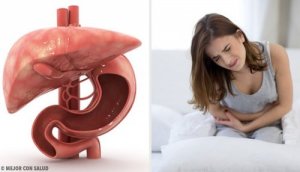5 Warning Signs of Fatty Liver Disease

What does the liver do?
If it can’t fulfill its functions, the health of the rest of the body deteriorates and therefore, the affected person begins to experience various discomforts, some of them so common that they can be confused with other health problems.
People who drink a lot of alcohol on a regular basis are prone to suffering from fatty liver. However, alcoholism isn’t the only risk factor associated with this disease. Other associated factors are:
- Suffering from diabetes
- Suffering from obesity or excess weight.
- Bad eating habits.
- High cholesterol levels, etc.
Five signs of fatty liver disease
In most cases, the hepatic steatosis doesn’t show any symptoms. In other words, until a proper examination is sought, it’s difficult to detect the disease. Some tests that help diagnose fatty liver disease are:
- Blood tests.
- Liver sonogram.
- Liver biopsy.
No set of signs specifically warn about fatty liver. However, we should note that some patients do experience symptoms, or certain health problems, that can be related to fatty liver. Discover them below.
1. Abdominal pain

Due to what some patients have experienced, one of the warning signs of fatty liver is abdominal pain. However, not the pain that manifests on its own, but the one that occurs along with other discomforts.
People experience it in the center or upper right part of the abdomen. However, it’s unrelated to a specific activity or effort. It can appear after eating because the stomach expands and presses on the enlarged liver.
2. Abdominal swelling
Another possible warning sign of fatty liver is abdominal swelling, which is also known as “ascites“. It consists of the presence of fluids between the visceral and parietal peritoneum and is usually a consequence of liver disease.
The symptoms of ascites are:
- Indigestion.
- Abdominal distension.
- Difficulty breathing.
- Pain in the back side of the back.
- Ankle swelling may also occur.
3. Fatigue
One of the possible warning signs of fatty liver is a lack of energy and constant fatigue. As the liver can’t work properly, the metabolism slows down, leading to unexplained tiredness.
It’s also possible to experience concentration problems, and confusion, among other symptoms.
4. Dark urine
We can detect problems or illnesses through urine. Let’s not forget that this liquid transports toxins and wastes. In cases of fatty liver disease, the fluid will be a darker color than normal. In addition, feces can also present changes: they might appear whiter or clayish with a stronger odor than normal.
5. Skin changes
Another of the warning signs of fatty liver is related to skin changes. The most significant change in the skin when there’s fatty liver is the appearance of jaundice. This yellow coloration appears on the skin and mucous membranes, due to the increase in the bilirubin accumulated in the tissues.
Here are other skin changes related to fatty liver:
- Capillary fragility.
- Discolored neck and armpits.
- Reddened palms of the hands.
- Spider veins on the back, chest, or shoulders.
- White spots under the nails.
We recommend you to read: 11 Signs of Liver Toxicity To Know Right Now
Diet and fatty liver disease

Once the fatty liver disease has been diagnosed, the next step is to start a proper treatment. In addition to the medication that your doctor may prescribe, it’s fundamental to follow a low fat diet.
Here are some recommendations:
- Reduce intake of refined foods. This food group includes flour and white sugar. Instead of these two, opt for whole grains.
- Follow a Mediterranean diet. The Mediterranean diet is one of the healthiest diets around because it’s based on foods that are low in fats or foods that have healthy fats.
- Avoid alcohol. Alcohol is one of the liver’s biggest enemies. Consuming too many alcoholic drinks can lead not only to steatosis but also to cirrhosis.
- Avoid certain medications. Consult your doctor to find out which drugs can worsen your condition.
- Exercise. Exercise is a great way to aid your hepatic system in functioning correctly. Experts recommend exercising for at least three times a week.
Remember that, while it’s important to rest, you need to get some exercise every day to promote the recovery process and, at the same time, support the health of the rest of the body. Therefore, try taking 30-40 minute walks every day or do a stretching session.
All cited sources were thoroughly reviewed by our team to ensure their quality, reliability, currency, and validity. The bibliography of this article was considered reliable and of academic or scientific accuracy.
- An, J. (2022). Nonalcoholic fatty liver disease. Sex/Gender-Specific Medicine in the Gastrointestinal Diseases, 197-207. https://link.springer.com/chapter/10.1007/978-981-19-0120-1_13
- Quimís, Y. (2020). Nutrición en el hígado graso no alcohólico. Polo del Conocimiento: Revista científico-profesional, 5(6), 419-438. https://dialnet.unirioja.es/servlet/articulo?codigo=7518097
- Engin, A. (2017). Non-alcoholic fatty liver disease. Obesity and Lipotoxicity, 443-467. https://link.springer.com/chapter/10.1007/978-3-319-48382-5_19
- Kim, D., & Kim, W. (2017). Nonobese fatty liver disease. Clinical gastroenterology and hepatology, 15(4), 474-485. https://www.sciencedirect.com/science/article/pii/S1542356516306085
- Maurice, J., & Manousou, P. (2018). Non-alcoholic fatty liver disease. Clinical medicine, 18(3), 245. https://www.ncbi.nlm.nih.gov/pmc/articles/PMC6334080/
- Meex, R., & Watt, M. (2017). Hepatokines: linking nonalcoholic fatty liver disease and insulin resistance. Nature Reviews Endocrinology, 13(9), 509-520. https://www.nature.com/articles/nrendo.2017.56
- Pafili, K., & Roden, M. (2021). Nonalcoholic fatty liver disease (NAFLD) from pathogenesis to treatment concepts in humans. Molecular Metabolism, 50. https://www.sciencedirect.com/science/article/pii/S2212877820301964
- Sweet, P., Khoo, T., & Nguyen, S. (2017). Nonalcoholic Fatty Liver Disease. Primary Care – Clinics in Office Practice. https://www.sciencedirect.com/science/article/abs/pii/S0095454317300970?via%3Dihub
- Tariq, T., & Desai, A. P. (2020). Nonalcoholic fatty liver disease: Making the diagnosis. Clinical Liver Disease, 16(2), 53. https://www.ncbi.nlm.nih.gov/pmc/articles/PMC7474145/
- Topal, E., Aydemir, K., Çağlar, Ö., Arda, B., Kayabaşı, O., Yıldız, M., Özyılmaz, E., & Erbaş, O. (2021). Fatty liver disease: Diagnosis and treatment. Journal of Experimental and Basic Medical Sciences, 2(3), 343-357. https://jebms.org/full-text/75
- Papatheodoridi, M., & Cholongitas, E. (2018). Diagnosis of non-alcoholic fatty liver disease (NAFLD): current concepts. Current pharmaceutical design, 24(38), 4574-4586. https://www.ingentaconnect.com/content/ben/cpd/2018/00000024/00000038/art00013
- Zheng, K., Fan, J., Shi, J., Wong, V., Eslam, M., George, J., & Zheng, M. (2020). From NAFLD to MAFLD: a” redefining” moment for fatty liver disease. Chinese medical journal, 133(19), 2271-2273. https://mednexus.org/doi/abs/10.1097/CM9.0000000000000981
- Zou, Y., Zhong, L., Hu, C., & Sheng, G. (2020). Association between the alanine aminotransferase/aspartate aminotransferase ratio and new-onset non-alcoholic fatty liver disease in a nonobese Chinese population: a population-based longitudinal study. Lipids in Health and Disease, 19(1), 1-10. https://lipidworld.biomedcentral.com/articles/10.1186/s12944-020-01419-z
This text is provided for informational purposes only and does not replace consultation with a professional. If in doubt, consult your specialist.








